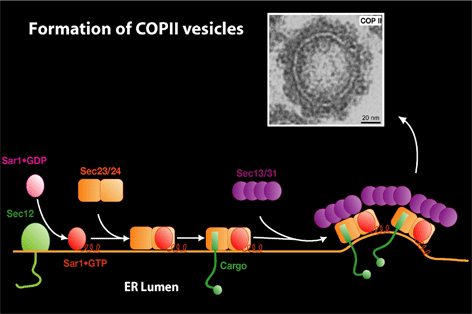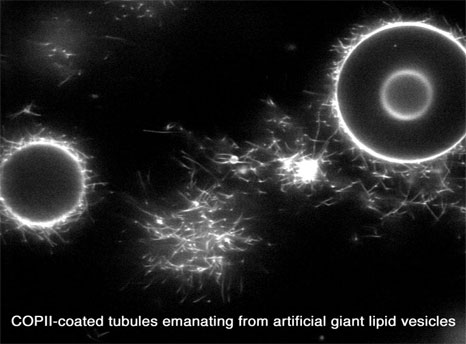 We have developed biochemical assays that measure the early events of polypeptide translocation into the endoplasmic reticulum (ER) and of vesicle-mediated protein transport from the ER to the Golgi apparatus. Transport of secretory and membrane cargo proteins is mediated by diffusible vesicles. The formation of these vesicles in vitro depends on the Sec proteins that were predicted to be involved from genetic and morphological inspection of sec mutant cells. Isolated transport vesicles contain membrane and internal proteins that are targeted to other compartments in the cell, but they are nearly devoid of proteins that are located in the ER. Thus, the budding mechanism somehow distinguishes transported from ER-resident proteins. This sorting and budding process is highly evolutionarily conserved; mammalian equivalents of the yeast Sec proteins have been isolated and are known to operate in the same location within the cell.
We have developed biochemical assays that measure the early events of polypeptide translocation into the endoplasmic reticulum (ER) and of vesicle-mediated protein transport from the ER to the Golgi apparatus. Transport of secretory and membrane cargo proteins is mediated by diffusible vesicles. The formation of these vesicles in vitro depends on the Sec proteins that were predicted to be involved from genetic and morphological inspection of sec mutant cells. Isolated transport vesicles contain membrane and internal proteins that are targeted to other compartments in the cell, but they are nearly devoid of proteins that are located in the ER. Thus, the budding mechanism somehow distinguishes transported from ER-resident proteins. This sorting and budding process is highly evolutionarily conserved; mammalian equivalents of the yeast Sec proteins have been isolated and are known to operate in the same location within the cell.
Vesicles formed in the transport reaction have an electron-dense, 10-nm coat structure that consists of the Sec proteins required in budding. This coat (COPII) resembles another coat complex (COPI) that creates transport vesicles within the Golgi apparatus. Our working model is that the Sec protein subunits of the COPII coat bind to the ER membrane and recruit cargo molecules into a cluster that then dimples the membrane to form a bud. A direct interaction between one of the COPII subunits, Sec24p, and membrane proteins is implicated in the capture of cargo proteins. This capture results in the concentrative sorting of membrane and secretory proteins, the latter being selected by an indirect interaction mediated by various membrane receptor proteins that link the coat to soluble cargo proteins. Fission of the bud from the membrane separates transported from resident proteins.
In addition to a role in cargo selection, the COPII coat is responsible for the membrane shape change that accompanies vesicle budding. Liposomes formulated with phospholipids representative of a yeast ER membrane fraction bind the COPII proteins in the same sequence of events and with the same nucleotide dependence as observed with native ER membrane. Furthermore, COPII buds and vesicles form on the surface of the liposome and capture solute from the interior of the liposome. Other coat protein complexes (clathrin and COPI) display similar budding activity on synthetic membrane liposomes.

Traffic in Human Genetic Diseases